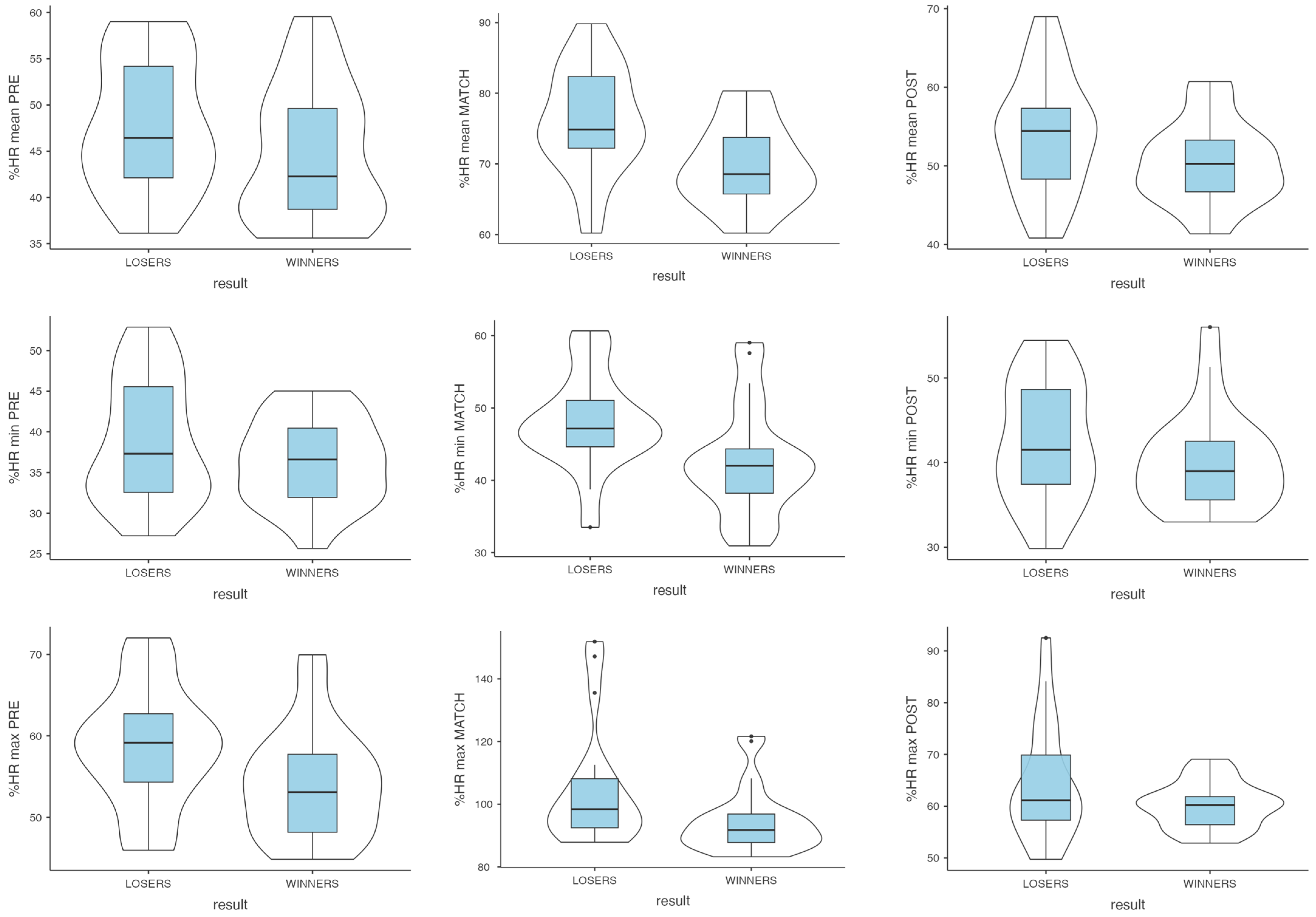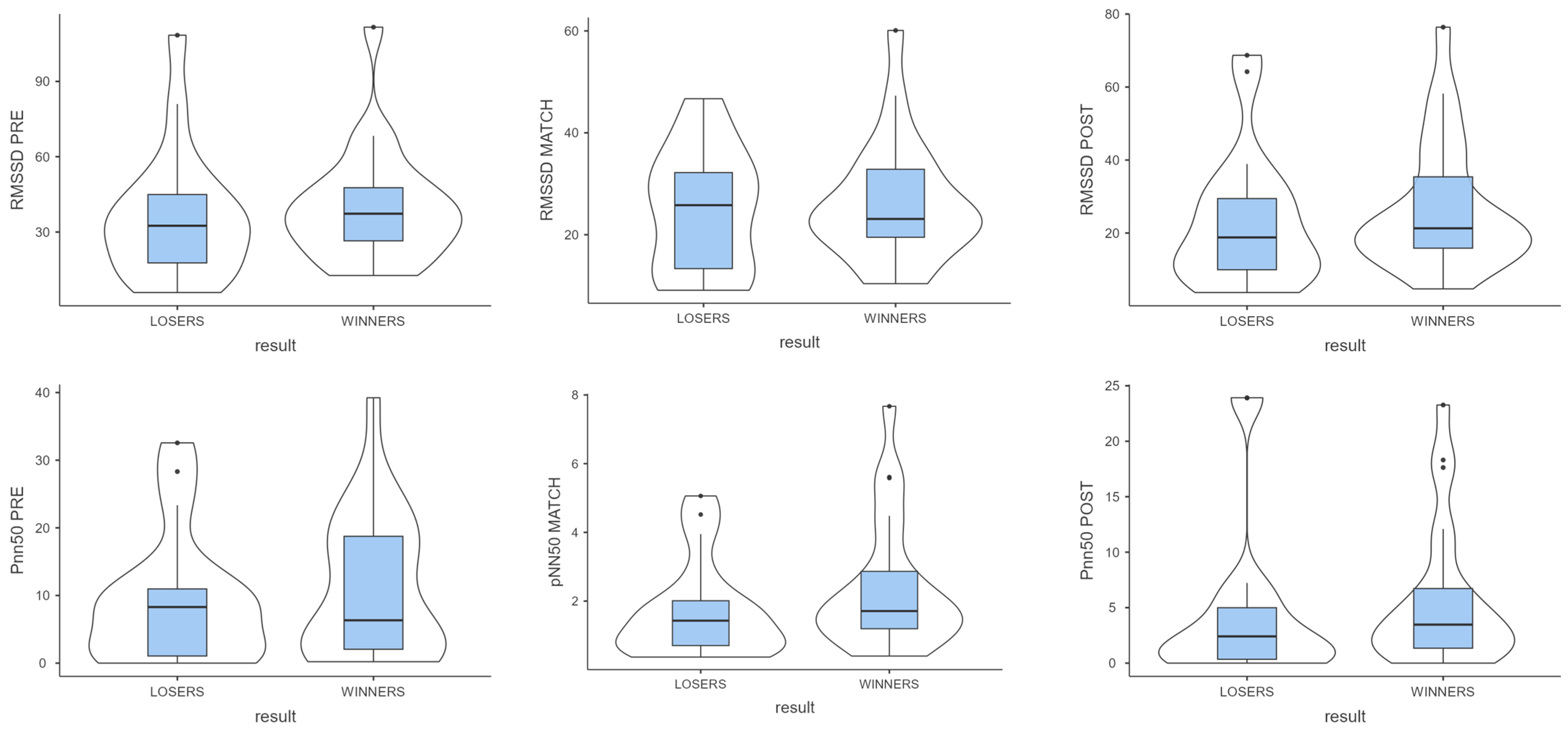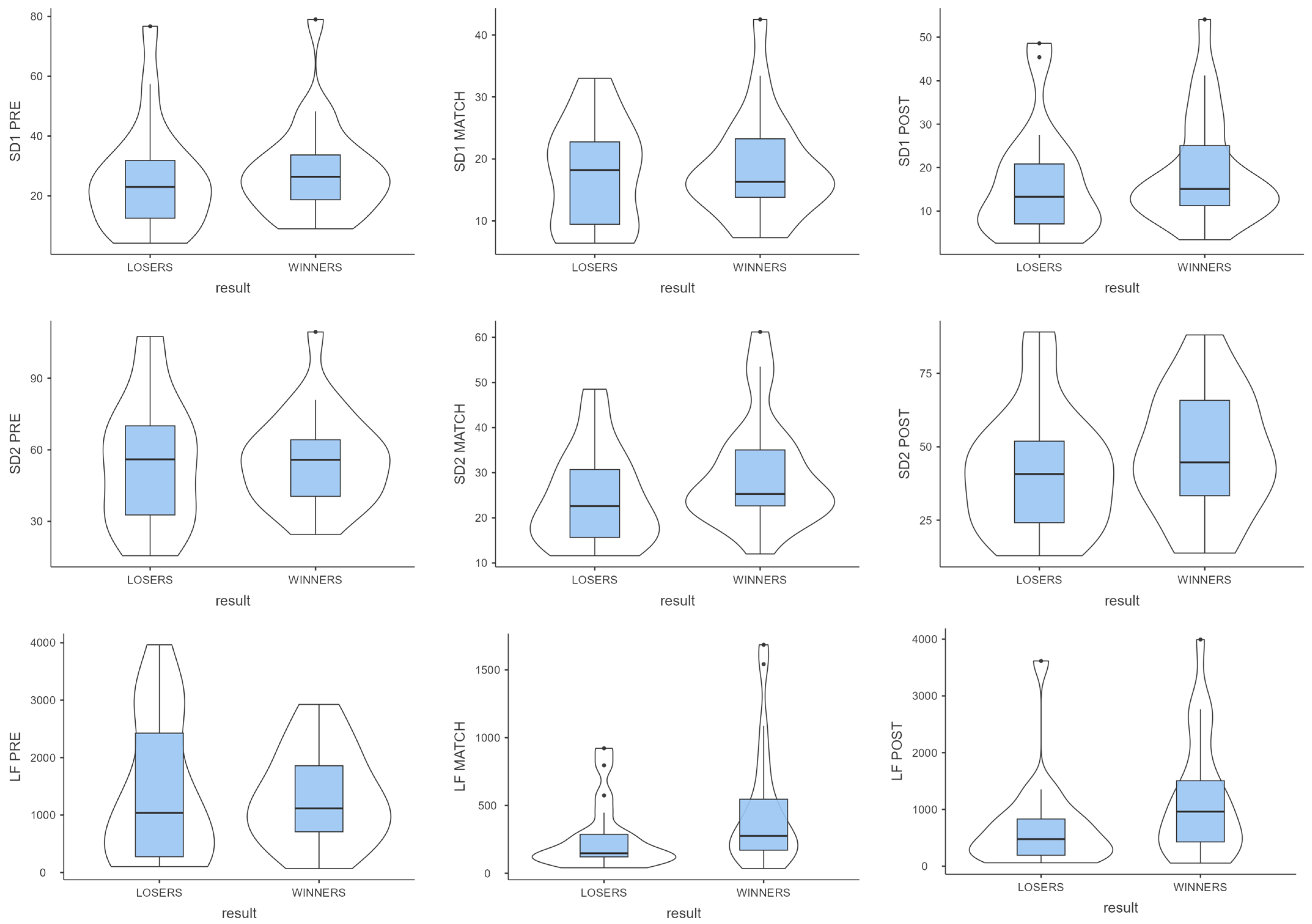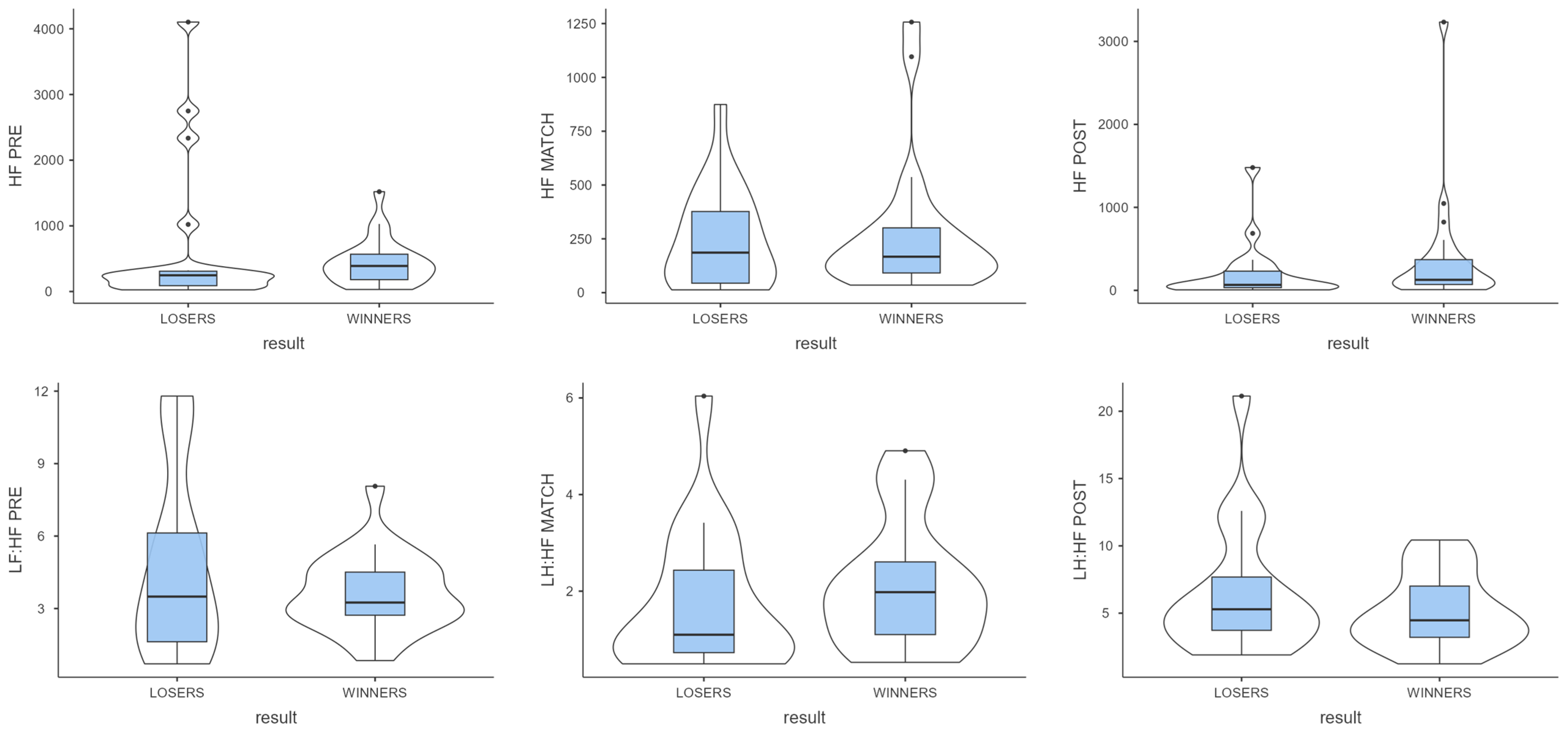Heart Rate Variability Differences by Match Phase and Outcome in Elite Male Finnish Padel Players
Abstract
1. Introduction
2. Materials and Methods
2.1. Participants
2.2. Instruments and Study Variables
2.3. Procedure
2.4. Statistical Analysis
3. Results
3.1. Significant Differences According to the Match Outcome
3.2. Significant Differences According to the Phase (Pre-Match, During the Match, Post-Match)
3.2.1. HR Variables
3.2.2. HRV Variables
Time-Domain Variables
Poincaré Variables
Frequency-Domain Variables
4. Discussion
Limitations and Future Studies
5. Conclusions
Author Contributions
Funding
Institutional Review Board Statement
Informed Consent Statement
Data Availability Statement
Conflicts of Interest
References
- Courel Ibáñez, J.; Sánchez Alcaraz Martínez, B.J.; García Benítez, S.; Echegaray, M. Evolución del pádel en España en función del género y edad de los practicantes. Cult. Cienc. Deporte 2017, 12, 39–46. [Google Scholar] [CrossRef]
- Castillo-Rodríguez, A.; Alvero-Cruz, J.R.; Hernández-Mendo, A.; Fernández-García, J.C. Physical and Physiological Responses in Paddle Tennis Competition. Int. J. Perform. Anal. Sport 2014, 14, 524–534. [Google Scholar] [CrossRef]
- Priego, J.I.; Olaso, J.; Llana, S.; Pérez, P.; Gonález, J.C.; Sanchís, M. Padel: A Quantitative Study of the Shots and Movements in the High-Performance. J. Hum. Sport Exerc. 2013, 8, 925–931. [Google Scholar] [CrossRef]
- Pradas, F.; Cachón, J.; Otín, D.; Quintas, A.; Arraco, S.I.; Castellar, C. Anthropometric, Physiological and Temporal Analysis in Elite Female Paddle Players [Análisis Antropométrico, Fisiológico y Temporal En Jugadoras de Pádel de Elite]. Retos Nuevas Tend. En Educ. Física Deporte Recreación 2014, 25, 107–122. [Google Scholar]
- Ramón-Llin, J.R.; Luján, J.F.G.; Gallego, R.M. Comparación de La Frecuencia Cardiaca En Competición, Entre Jugadores de Pádel de Elite y de Categoría Nacional. Retos Nuevas Tend. En Educ. Fis. Deporte Recreacion 2018, 33, 91–95. [Google Scholar]
- Carrasco, L.; Romero, S.; Sañudo, B.; De Hoyo, M. Game Analysis and Energy Requirements of Paddle Tennis Competition. Sci. Sports 2011, 26, 338–344. [Google Scholar] [CrossRef]
- Bustamante-Sánchez, Á.; Sebastián, A.A.d.S.; Padilla-Crespo, A. El set disputado influye en la variabilidad de la frecuencia cardiaca en jugadores de pádel de élite. Padel Sci. J. 2024, 2, 139–150. [Google Scholar] [CrossRef]
- Díaz-García, J.; López-Gajardo, M.Á.; Ponce-Bordón, J.C.; Pulido, J.J. Is Motivation Associated with Mental Fatigue during Padel Trainings? A Pilot Study. Sustainability 2021, 13, 5755. [Google Scholar] [CrossRef]
- Parraca, J.A.; Alegrete, J.; Villafaina, S.; Batalha, N.; Fuentes-García, J.P.; Muñoz, D.; Fernandes, O.; Parraca, J.A.; Alegrete, J.; Villafaina, S.; et al. Heart Rate Variability Monitoring during a Padel Match. Int. J. Environ. Res. Public Health 2022, 19, 3623. [Google Scholar] [CrossRef] [PubMed]
- Villafaina, S.; Crespo, M.; Martínez-Gallego, R.; Fuentes-García, J.P. Heart Rate Variability in Elite International ITF Junior Davis Cup Tennis Players. Biology 2022, 12, 17. [Google Scholar] [CrossRef]
- Laborde, S.; Mosley, E.; Thayer, J.F. Heart Rate Variability and Cardiac Vagal Tone in Psychophysiological Research—Recommendations for Experiment Planning, Data Analysis, and Data Reporting. Front. Psychol. 2017, 8, 213. [Google Scholar] [CrossRef]
- Rodas, G.; Pedret Carballido, C.; Ramos, J. Variabilidad de La Frecuencia Cardiaca: Concepto, Medidas y Relación Con Aspectos Clínicos (I). Arch. Med. Deporte 2008, 25, 41–47. [Google Scholar]
- Cervantes Blásquez, J.C.; Rodas Font, G.; Capdevila Ortís, L. Heart-Rate Variability and Precompetitive Anxiety in Swimmers. Psicothema 2009, 21, 531–536. [Google Scholar]
- Shaffer, F.; McCraty, R.; Zerr, C.L. A Healthy Heart Is Not a Metronome: An Integrative Review of the Heart’s Anatomy and Heart Rate Variability. Front. Psychol. 2014, 5, 1040. [Google Scholar] [CrossRef] [PubMed]
- Mourot, L.; Bouhaddi, M.; Perrey, S.; Cappelle, S.; Henriet, M.-T.; Wolf, J.-P.; Rouillon, J.-D.; Regnard, J. Decrease in Heart Rate Variability with Overtraining: Assessment by the Poincaré Plot Analysis. Clin. Physiol. Funct. Imaging 2004, 24, 10–18. [Google Scholar] [CrossRef] [PubMed]
- Schmitt, L.; Regnard, J.; Millet, G.P. Monitoring Fatigue Status with HRV Measures in Elite Athletes: An Avenue Beyond RMSSD? Front. Physiol. 2015, 6, 343. [Google Scholar] [CrossRef] [PubMed]
- Rodas, G.; Yanguas, X.; Pedret, C.; Ramos, J.; Capdevila, L. Cambios En La Variabilidad de La Frecuencia Cardiaca (VFC) En Jugadores de Hockey Hierba Durante El Campeonato Del Mundo de 2006. Apunts Med. Esport 2011, 46, 117–123. [Google Scholar] [CrossRef][Green Version]
- Rebelo, A.; Pereira, J.R.; Valente-dos-Santos, J. Effects of a Preseason Triphasic Resistance Training Program on Athletic Performance in Elite Volleyball Players—An Observational Study. Ger. J. Exerc. Sport Res. 2023, 53, 163–170. [Google Scholar] [CrossRef]
- World Medical Association. World Medical Association Declaration of Helsinki: Ethical Principles for Medical Research Involving Human Subjects. JAMA 2013, 310, 2191–2194. [Google Scholar] [CrossRef]
- Lechner, S.; Ammar, A.; Boukhris, O.; Trabelsi, K.; Glenn, J.M.; Schwarz, J.; Hammouda, O.; Zmijewski, P.; Chtourou, H.; Driss, T.; et al. Monitoring Training Load in Youth Soccer Players: Effects of a Six-Week Preparatory Training Program and the Associations between External and Internal Loads. Biol. Sport 2022, 40, 63–75. [Google Scholar] [CrossRef]
- Tanaka, H.; Monahan, K.D.; Seals, D.R. Age-Predicted Maximal Heart Rate Revisited. J. Am. Coll. Cardiol. 2001, 37, 153–156. [Google Scholar] [CrossRef]
- Shaffer, F.; Ginsberg, J.P. An Overview of Heart Rate Variability Metrics and Norms. Front. Public Health 2017, 5, 258. [Google Scholar] [CrossRef]
- Catai, A.M.; Pastre, C.M.; de Godoy, M.F.; da Silva, E.; de Takahashi, A.C.M.; Vanderlei, L.C.M. Heart Rate Variability: Are You Using It Properly? Standardisation Checklist of Procedures. Braz. J. Phys. Ther. 2020, 24, 91–102. [Google Scholar] [CrossRef]
- Heart Rate Variability: Standards of Measurement, Physiological Interpretation and Clinical Use. Task Force of the European Society of Cardiology and the North American Society of Pacing and Electrophysiology. Circulation 1996, 93, 1043–1065. [CrossRef]
- Coolican, H.; Coolican, H. Research Methods and Statistics in Psychology, 6th ed.; Psychology Press: London, UK, 2014; ISBN 978-0-203-76983-6. [Google Scholar]
- Fritz, C.O.; Morris, P.E.; Richler, J.J. Effect Size Estimates: Current Use, Calculations, and Interpretation. J. Exp. Psychol. Gen. 2012, 141, 2–18. [Google Scholar] [CrossRef]
- Kerby, D.S. The Simple Difference Formula: An Approach to Teaching Nonparametric Correlation. Compr. Psychol. 2014, 3, 11.IT.3.1. [Google Scholar] [CrossRef]
- Dinkelberg, T.S. The Discriminating Factors of Winning and Losing in Elite Wheelchair Tennis. Master’s Thesis, TU Delft, Delft, The Netherlands, 2019; pp. 1–43. [Google Scholar]
- Navas, D.; Veiga, S.; Navarro, E.; Ramón-Llín, J. Differences in Kinematic and Match-Play Demands between Elite Winning and Losing Wheelchair Padel Players. PLoS ONE 2020, 15, e0233475. [Google Scholar] [CrossRef]
- Vučkovic, G.; James, N. The Distance Covered by Winning and Losing Players in Elite Squash Matches. Kinesiol. Slov. 2010, 16, 44–50. [Google Scholar]
- Roldán-Márquez, R.; Onetti-Onetti, W.; Alvero-Cruz, J.R.; Castillo-Rodríguez, A. Win or Lose. Physical and Physiological Responses in Paddle Tennis Competition According to the Game Result. Int. J. Perform. Anal. Sport 2022, 22, 479–490. [Google Scholar] [CrossRef]
- Villafaina, S.; Fuentes-García, J.P.; Fernandes, O.; Muñoz, D.; Batalha, N.; Parraca, J.A. The Impact of Winning or Losing a Padel Match on Heart Rate Variability. Int. J. Sports Sci. Coach. 2024, 19, 1296–1305. [Google Scholar] [CrossRef]
- Rogers, B.; Giles, D.; Draper, N.; Hoos, O.; Gronwald, T. A New Detection Method Defining the Aerobic Threshold for Endurance Exercise and Training Prescription Based on Fractal Correlation Properties of Heart Rate Variability. Front. Physiol. 2021, 11, 596567. [Google Scholar] [CrossRef]
- Jones, M.V.; Sheffield, D. The Impact of Game Outcome on the Well-being of Athletes. Int. J. Sport Exerc. Psychol. 2007, 5, 54–65. [Google Scholar] [CrossRef]
- Mather, M.; Thayer, J.F. How Heart Rate Variability Affects Emotion Regulation Brain Networks. Curr. Opin. Behav. Sci. 2018, 19, 98–104. [Google Scholar] [CrossRef] [PubMed]
- Boullosa, D.A.; Abreu, L.; Nakamura, F.Y.; Muñoz, V.E.; Domínguez, E.; Leicht, A.S. Cardiac Autonomic Adaptations in Elite Spanish Soccer Players During Preseason. Int. J. Sports Physiol. Perform. 2013, 8, 400–409. [Google Scholar] [CrossRef]
- Ravé, G.; Fortrat, J.-O. Heart Rate Variability in the Standing Position Reflects Training Adaptation in Professional Soccer Players. Eur. J. Appl. Physiol. 2016, 116, 1575–1582. [Google Scholar] [CrossRef]
- Laborde, S.; Wanders, J.; Mosley, E.; Javelle, F. Influence of Physical Post-Exercise Recovery Techniques on Vagally-Mediated Heart Rate Variability: A Systematic Review and Meta-Analysis. Clin. Physiol. Funct. Imaging 2024, 44, 14–35. [Google Scholar] [CrossRef]




| Pre | During | Post | |||||||
|---|---|---|---|---|---|---|---|---|---|
| Win | Lose | Win | Lose | Win | Lose | Match Effect | |||
| M ± SD | M ± SD | M ± SD | M ± SD | M ± SD | M ± SD | χ2 | p | W | |
| %HRmean | 44.71 ± 7.33 | 47.86 ± 7.25 | 69.80 ± 5.76 * | 76.16 ± 7.53 | 50.41 ± 5.22 | 53.93 ± 7.52 | 69.9 | <0.001 | 0.554 |
| %HRmin | 36.41 ± 5.30 | 38.88 ± 7.63 | 42.45 ± 7.46 * | 48.08 ± 6.64 | 40.21 ± 5.78 | 42.46 ± 7.08 | 32.6 | <0.001 | 0.258 |
| %HRmax | 54.19 ± 6.75 | 58.57 ± 7.41 | 94.60 ± 10.30 * | 104.90 ± 19.27 | 60.19 ± 4.44 | 64.31 ± 11.38 | 68.8 | <0.001 | 0.546 |
| HRmean (bpm) | 85.5 ± 13.18 | 90.95 ± 12.39 | 134.17 ± 10.07 * | 144.89 ± 12.81 | 96.96 ± 10.21 | 102.53 ± 12.88 | 69.9 | <0.001 | 0.554 |
| HRmin (bpm) | 69.96 ± 9.70 | 73.89 ± 13.72 | 81.52 ± 13.45 * | 91.47 ± 11.80 | 77.35 ± 11.21 | 80.74 ± 12.71 | 32.6 | <0.001 | 0.258 |
| HRmax (bpm) | 104.13 ± 12.01 | 111.37 ± 12.78 | 181.96 ± 20.24 * | 199.47 ± 34.94 | 115.78 ± 9.07 | 122.26 ± 20.17 | 68.8 | <0.001 | 0.546 |
| RMSSD (ms) | 39.60 ± 22.11 | 35.95 ± 25.83 | 26.15 ± 11.75 | 24.52 ± 12.02 | 26.86 ± 17.70 | 23.01 ± 18.42 | 14.9 | <0.001 | 0.118 |
| pNN50 (%) | 11.04 ± 10.64 | 9.11 ± 9.67 | 2.40 ± 1.88 | 1.72 ± 1.42 | 5.72 ± 6.42 | 4.48 ± 7.21 | 13.9 | <0.001 | 0.110 |
| SD1 (ms) | 28.03 ± 15.65 | 25.46 ± 18.30 | 18.49 ± 8.31 | 17.33 ± 8.50 | 19.03 ± 12.52 | 16.28 ± 13.02 | 15.5 | <0.001 | 0.123 |
| SD2 (ms) | 55.65 ± 19.39 | 54.39 ± 26.34 | 29.97 ± 12.06 | 24.30 ± 10.48 | 47.41 ± 20.87 | 41.59 ± 20.70 | 41.8 | <0.001 | 0.331 |
| LF (ms2) | 1316.91 ± 812.00 | 1366.42 ± 1253.38 | 456.52 ± 450.66 | 264.26 ± 249.77 | 1143.30 ± 1040.944 | 692.74 ± 810.061 | 33.8 | <0.001 | 0.268 |
| HF (ms2) | 436.48 ± 353.07 | 670.16 ± 1128.97 | 275.96 ± 313.00 | 249.79 ± 234.24 | 386.35 ± 677.06 | 210.32 ± 352.35 | 13.5 | 0.001 | 0.107 |
| LF/HF | 3.65 ± 1.60 | 4.78 ± 3.86 | 2.08 ± 1.29 | 1.75 ± 1.46 | 5.14 ± 2.75 | 6.57 ± 4.84 | 32.8 | <0.001 | 0.260 |
Disclaimer/Publisher’s Note: The statements, opinions and data contained in all publications are solely those of the individual author(s) and contributor(s) and not of MDPI and/or the editor(s). MDPI and/or the editor(s) disclaim responsibility for any injury to people or property resulting from any ideas, methods, instructions or products referred to in the content. |
© 2025 by the authors. Licensee MDPI, Basel, Switzerland. This article is an open access article distributed under the terms and conditions of the Creative Commons Attribution (CC BY) license (https://creativecommons.org/licenses/by/4.0/).
Share and Cite
Conde-Ripoll, R.; Jamotte, A.; Parraca, J.A.; Bustamante-Sánchez, Á. Heart Rate Variability Differences by Match Phase and Outcome in Elite Male Finnish Padel Players. J. Funct. Morphol. Kinesiol. 2025, 10, 306. https://doi.org/10.3390/jfmk10030306
Conde-Ripoll R, Jamotte A, Parraca JA, Bustamante-Sánchez Á. Heart Rate Variability Differences by Match Phase and Outcome in Elite Male Finnish Padel Players. Journal of Functional Morphology and Kinesiology. 2025; 10(3):306. https://doi.org/10.3390/jfmk10030306
Chicago/Turabian StyleConde-Ripoll, Rafael, Antonin Jamotte, Jose A. Parraca, and Álvaro Bustamante-Sánchez. 2025. "Heart Rate Variability Differences by Match Phase and Outcome in Elite Male Finnish Padel Players" Journal of Functional Morphology and Kinesiology 10, no. 3: 306. https://doi.org/10.3390/jfmk10030306
APA StyleConde-Ripoll, R., Jamotte, A., Parraca, J. A., & Bustamante-Sánchez, Á. (2025). Heart Rate Variability Differences by Match Phase and Outcome in Elite Male Finnish Padel Players. Journal of Functional Morphology and Kinesiology, 10(3), 306. https://doi.org/10.3390/jfmk10030306









